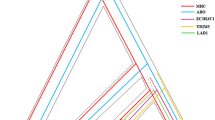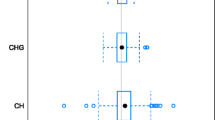Abstract
The human TRIM5 genes encodes a retroviral restriction factor (TRIM5α). Evolutionary analyses of this gene in mammals have revealed a complex and multifaceted scenario, suggesting that TRIM5 has been the target of exceptionally strong selective pressures, possibly exerted by recurrent waves of retroviral infections. TRIM5 displays inter-individual expression variability in humans and high levels of TRIM5 mRNA have been associated with a reduced risk of HIV-1 infection. We resequenced TRIM5 in chimpanzees and identified two polymorphisms in intron 1 that are shared with humans. Analysis of the gene region encompassing the two trans-specific variants in human populations identified exceptional nucleotide diversity levels and an excess of polymorphism compared to fixed divergence. Most tests rejected the null hypothesis of neutral evolution for this region and haplotype analysis revealed the presence of two deeply separated clades. Calculation of the time to the most recent common ancestor (TMRCA) for TRIM5 haplotypes yielded estimates ranging between 4 and 7 million years. Overall, these data indicate that long-term balancing selection, an extremely rare process outside MHC genes, has maintained trans-specific polymorphisms in the first intron of TRIM5. Bioinformatic analyses indicated that variants in intron 1 may affect transcription factor-binding sites and, therefore, TRIM5 transcriptional activity. Data herein confirm an extremely complex evolutionary history of TRIM5 genes in primates and open the possibility that regulatory variants in the gene modulate the susceptibility to HIV-1.





Similar content being viewed by others
References
Asthana S, Schmidt S, Sunyaev S (2005) A limited role for balancing selection. Trends Genet 21:30–32. doi:10.1016/j.tig.2004.11.001
Bamshad MJ, Mummidi S, Gonzalez E, Ahuja SS, Dunn DM, Watkins WS, Wooding S, Stone AC, Jorde LB, Weiss RB, Ahuja SK (2002) A strong signature of balancing selection in the 5′ cis-regulatory region of CCR5. Proc Natl Acad Sci USA 99:10539–10544. doi:10.1073/pnas.162046399
Bandelt HJ, Forster P, Sykes BC, Richards MB (1995) Mitochondrial portraits of human populations. Genetics 141:743–753
Barrett JC, Fry B, Maller J, Daly MJ (2005) Haploview: analysis and visualization of LD and haplotype maps. Bioinformatics 21:263–265
Cagliani R, Fumagalli M, Riva S, Pozzoli U, Comi GP, Menozzi G, Bresolin N, Sironi M (2008) The signature of long-standing balancing selection at the human defensin beta-1 promoter. Genome Biol 9:R143. doi:10.1186/gb-2008-9-9-r143
Charlesworth D (2006) Balancing selection and its effects on sequences in nearby genome regions. PLoS Genet 2:e64. doi:10.1371/journal.pgen.0020064
Cooper GM, Brudno M, Stone EA, Dubchak I, Batzoglou S, Sidow A (2004) Characterization of evolutionary rates and constraints in three mammalian genomes. Genome Res 14:539–548
Emerman M, Malik HS (2010) Paleovirology—modern consequences of ancient viruses. PLoS Biol 8:e1000301. doi:10.1371/journal.pbio.1000301
Evans PD, Gilbert SL, Mekel-Bobrov N, Vallender EJ, Anderson JR, Vaez-Azizi LM, Tishkoff SA, Hudson RR, Lahn BT (2005) Microcephalin, a gene regulating brain size, continues to evolve adaptively in humans. Science 309:1717–1720. doi:10.1126/science.1113722
Forster P, Harding R, Torroni A, Bandelt H-J (1996) Origin and evolution of native American mtDNA variation: a reappraisal. Am J Hum Genet 59:935–945
Fu YX, Li WH (1993) Statistical tests of neutrality of mutations. Genetics 133:693–709
Fumagalli M, Cagliani R, Pozzoli U, Riva S, Comi GP, Menozzi G, Bresolin N, Sironi M (2009) Widespread balancing selection and pathogen-driven selection at blood group antigen genes. Genome Res 19:199–212. doi:10.1101/gr.082768.108
Gabriel SB, Schaffner SF, Nguyen H, Moore JM, Roy J, Blumenstiel B, Higgins J, DeFelice M, Lochner A, Faggart M, Liu-Cordero SN, Rotimi C, Adeyemo A, Cooper R, Ward R, Lander ES, Daly MJ, Altschuler D (2002) The structure of haplotype blocks in the human genome. Science 296:2225–2229
Glazko GV, Nei M (2003) Estimation of divergence times for major lineages of primate species. Mol Biol Evol 20:424–434
Goldschmidt V, Bleiber G, May M, Martinez R, Ortiz M, Telenti A, Swiss HIV cohort study (2006) Role of common human TRIM5α variants in HIV-1 disease progression. Retrovirology 3:54. doi:10.1186/1742-4690-3-54
Griffiths RC, Tavare S (1994) Sampling theory for neutral alleles in a varying environment. Philos Trans R Soc Lond B Biol Sci 344:403–410. doi:10.1098/rstb.1994.0079
Griffiths RC, Tavare S (1995) Unrooted genealogical tree probabilities in the infinitely-many-sites model. Math Biosci 127:77–98
Heinemeyer T, Wingender E, Reuter I, Hermjakob H, Kel AE, Kel OV, Ignatieva EV, Ananko EA, Podkolodnaya OA, Kolpakov FA, Podkolodny NL, Kolchanov NA (1998) Databases on transcriptional regulation: TRANSFAC, TRRD and COMPEL. Nucleic Acids Res 26:362–367
Hudson RR, Kreitman M, Aguade M (1987) A test of neutral molecular evolution based on nucleotide data. Genetics 116:153–159
Javanbakht H, An P, Gold B, Petersen DC, O’Huigin C, Nelson GW, O’Brien SJ, Kirk GD, Detels R, Buchbinder S, Donfield S, Shulenin S, Song B, Perron MJ, Stremlau M, Sodroski J, Dean M, Winkler C (2006) Effects of human TRIM5α polymorphisms on antiretroviral function and susceptibility to human immunodeficiency virus infection. Virology 354:15–27. doi:10.1016/j.virol.2006.06.031
Johnson WE, Sawyer SL (2009) Molecular evolution of the antiretroviral TRIM5 gene. Immunogenetics 61:163–176. doi:10.1007/s00251-009-0358-y
Jordan IK, Rogozin IB, Glazko GV, Koonin EV (2003) Origin of a substantial fraction of human regulatory sequences from transposable elements. Trends Genet 19:68–72
Kaiser SM, Malik HS, Emerman M (2007) Restriction of an extinct retrovirus by the human TRIM5α antiviral protein. Science 316:1756–1758. doi:10.1126/science.1140579
Karlin S, Altschul SF (1990) Methods for assessing the statistical significance of molecular sequence features by using general scoring schemes. Proc Natl Acad Sci USA 87:2264–2268
Karlin S, Altschul SF (1993) Applications and statistics for multiple high-scoring segments in molecular sequences. Proc Natl Acad Sci USA 90:5873–5877
Liu X, Fu Y, Liu Z, Lin B, Xie Y, Liu Y, Xu Y, Lin J, Fan X, Dong M, Zeng K, Wu CI, Xu A (2006) An ancient balanced polymorphism in a regulatory region of human major histocompatibility complex is retained in Chinese minorities but lost worldwide. Am J Hum Genet 78:393–400. doi:10.1086/500593
Loisel DA, Rockman MV, Wray GA, Altmann J, Alberts SC (2006) Ancient polymorphism and functional variation in the primate MHC-DQA1 5’ cis-regulatory region. Proc Natl Acad Sci USA 103:16331–16336. doi:10.1073/pnas.0607662103
Marth GT, Czabarka E, Murvai J, Sherry ST (2004) The allele frequency spectrum in genome-wide human variation data reveals signals of differential demographic history in three large world populations. Genetics 166:351–372
Nei M, Li WH (1979) Mathematical model for studying genetic variation in terms of restriction endonucleases. Proc Natl Acad Sci USA 76:5269–5273
Newman RM, Hall L, Connole M, Chen GL, Sato S, Yuste E, Diehl W, Hunter E, Kaur A, Miller GM, Johnson WE (2006) Balancing selection and the evolution of functional polymorphism in Old World monkey TRIM5α. Proc Natl Acad Sci USA 103:19134–19139. doi:10.1073/pnas.0605838103
R Development Core Team (2008) R: a language and environment for statistical computing, Vienna, Austria
Sawyer S (1989) Statistical tests for detecting gene conversion. Mol Biol Evol 6:526–538
Sawyer SL, Wu LI, Akey JM, Emerman M, Malik HS (2006) High-frequency persistence of an impaired allele of the retroviral defense gene TRIM5α in humans. Curr Biol 16:95–100. doi:10.1016/j.cub.2005.11.045
Sawyer SL, Emerman M, Malik HS (2007) Discordant evolution of the adjacent antiretroviral genes TRIM22 and TRIM5 in mammals. PLoS Pathog 3:e197. doi:10.1371/journal.ppat.0030197
Schaffner SF, Foo C, Gabriel S, Reich D, Daly MJ, Altshuler D (2005) Calibrating a coalescent simulation of human genome sequence variation. Genome Res 15:1576–1583. doi:10.1101/gr.3709305
Sewram S, Singh R, Kormuth E, Werner L, Mlisana K, Karim SS, Ndung’u T (2009) CAPRISA Acute Infection Study Team Human TRIM5alpha expression levels and reduced susceptibility to HIV-1 infection. J Infect Dis 199:1657–1663. doi:10.1086/598861
Song B, Gold B, O’Huigin C, Javanbakht H, Li X, Stremlau M, Winkler C, Dean M, Sodroski J (2005) The B30.2(SPRY) domain of the retroviral restriction factor TRIM5alpha exhibits lineage-specific length and sequence variation in primates. J Virol 79:6111–6121. doi:10.1128/JVI.79.10.6111-6121.2005
Speelmon EC, Livingston-Rosanoff D, Li SS, Vu Q, Bui J, Geraghty DE, Zhao LP, McElrath MJ (2006) Genetic association of the antiviral restriction factor TRIM5α with human immunodeficiency virus type 1 infection. J Virol 80:2463–2471. doi:10.1128/JVI.80.5.2463-2471.2006
Stephens M, Scheet P (2005) Accounting for decay of linkage disequilibrium in haplotype inference and missing-data imputation. Am J Hum Genet 76:449–462. doi:10.1086/428594
Stephens M, Smith NJ, Donnelly P (2001) A new statistical method for haplotype reconstruction from population data. Am J Hum Genet 68:978–989. doi:10.1086/319501
Stremlau M, Owens CM, Perron MJ, Kiessling M, Autissier P, Sodroski J (2004) The cytoplasmic body component TRIM5α restricts HIV-1 infection in Old World monkeys. Nature 427:848–853. doi:10.1038/nature02343
Stremlau M, Perron M, Lee M, Li Y, Song B, Javanbakht H, Diaz-Griffero F, Anderson DJ, Sundquist WI, Sodroski J (2006) Specific recognition and accelerated uncoating of retroviral capsids by the TRIM5α restriction factor. Proc Natl Acad Sci USA 103:5514–5519. doi:10.1073/pnas.0509996103
Tajima F (1989) Statistical method for testing the neutral mutation hypothesis by DNA polymorphism. Genetics 123:585–595
Tan Z, Shon AM, Ober C (2005) Evidence of balancing selection at the HLA-G promoter region. Hum Mol Genet 14:3619–3628. doi:10.1093/hmg/ddi389
Tareen SU, Sawyer SL, Malik HS, Emerman M (2009) An expanded clade of rodent Trim5 genes. Virology 385:473–483. doi:10.1016/j.virol.2008.12.018
Thornton K (2003) Libsequence: a C++ class library for evolutionary genetic analysis. Bioinformatics 19:2325–2327
Tishkoff SA, Verrelli BC (2003) Patterns of human genetic diversity: implications for human evolutionary history and disease. Annu Rev Genomics Hum Genet 4:293–340. doi:10.1146/annurev.genom.4.070802.110226
van de Lagemaat LN, Landry JR, Mager DL, Medstrand P (2003) Transposable elements in mammals promote regulatory variation and diversification of genes with specialized functions. Trends Genet 19:530–536
van Manen D, Rits MA, Beugeling C, van Dort K, Schuitemaker H, Kootstra NA (2008) The effect of Trim5 polymorphisms on the clinical course of HIV-1 infection. PLoS Pathog 4:e18. doi:10.1371/journal.ppat.0040018
Virgen CA, Kratovac Z, Bieniasz PD, Hatziioannou T (2008) Independent genesis of chimeric TRIM5-cyclophilin proteins in two primate species. Proc Natl Acad Sci USA 105:3563–3568. doi:10.1073/pnas.0709258105
Voight BF, Adams AM, Frisse LA, Qian Y, Hudson RR, Di Rienzo A (2005) Interrogating multiple aspects of variation in a full resequencing data set to infer human population size changes. Proc Natl Acad Sci USA 102:18508–18513. doi:10.1073/pnas.0507325102
Watterson GA (1975) On the number of segregating sites in genetical models without recombination. Theor Popul Biol 7:256–276
Wright SI, Charlesworth B (2004) The HKA test revisited: a maximum-likelihood-ratio test of the standard neutral model. Genetics 168:1071–1076. doi:10.1534/genetics.104.026500
Zogopoulos G, Ha KC, Naqib F, Moore S, Kim H, Montpetit A, Robidoux F, Laflamme P, Cotterchio M, Greenwood C, Scherer SW, Zanke B, Hudson TJ, Bader GD, Gallinger S (2007) Germ-line DNA copy number variation frequencies in a large North American population. Hum Genet 122:345–353. doi:10.1007/s00439-007-0404-5
Acknowledgments
MC is supported by grants from Istituto Superiore di Sanita’ “Programma Nazionale di Ricerca sull’ AIDS”, the EMPRO and AVIP EC WP6 Projects, the nGIN EC WP7 Project, the Japan Health Science Foundation, 2008 Ricerca Finalizzata [Italian Ministry of Health], 2008 Ricerca Corrente [Italian Ministry of Health], Progetto FIRB RETI: Rete Italiana Chimica Farmaceutica CHEM-PROFARMA-NET [RBPR05NWWC], and Fondazione CARIPLO. MS is a member of the Doctorate School in Molecular Medicine, University of Milan.
Author information
Authors and Affiliations
Corresponding author
Electronic supplementary material
Below is the link to the electronic supplementary material.
Rights and permissions
About this article
Cite this article
Cagliani, R., Fumagalli, M., Biasin, M. et al. Long-term balancing selection maintains trans-specific polymorphisms in the human TRIM5 gene. Hum Genet 128, 577–588 (2010). https://doi.org/10.1007/s00439-010-0884-6
Received:
Accepted:
Published:
Issue Date:
DOI: https://doi.org/10.1007/s00439-010-0884-6




